This is a long overdue update to an article I first wrote in 2018. When I published it, the emphasis was solely on rifle optics. In this new era of “pistol optics all the things,” it was time to address that side of the house, too.
Let’s rewind the clock back to 2014. After attending my first Appleseed shoot and using an iron-sighted 20″ rifle, I was all hopped up on evangelizing for the church iron sights. I treated them like some kind of magic voodoo that I had learned, and that magic made me a real rifleman.
I didn’t think I was acting that way, of course. But I was.
As time has gone on and I’ve deepened my experience with a variety of rifles, pistols, optics, and iron sights, the more I realize that we need to set the baseline of what the fundamentals actually are. In the modern era, people who insist that you need to learn iron sights first before using optics are the same kinds of people who think you should learn how to drive a manual transmission before an automatic. The fact that the latter is far more common and many people will never get exposure to a stick shift in their driving life is irrelevant.
So let’s get into it.
Iron Sights are a Skill, Not a Fundamental
Let’s say you’re browsing the marksmanship board of your favorite gun-related forum. While looking for discussions about teaching new shooters, you find someone telling the group that you need to start new shooters off on iron sights.
“Start them with the fundamentals, and then work them up to red dots and other optics.”
– Said by someone who is wrong
Iron sights are tool for aligning the point of aim and point of impact. That is their sole purpose in life, the same as any other sighting device be it a red dot or a magnified optic. There is nothing special about them in that regard. In fact, they actually complicate the process by introducing additional variables.
Let’s review…
The Fundamentals of Marksmanship
The fundamentals of marksmanship are simple.
- Steady Position
- Sight alignment
- Sight picture
- Controlled Breathing
- Trigger Control
Notice that you didn’t see iron sights listed there. You can further break down aiming into two elements: sight alignment and sight picture.
Sight Alignment is a ensuring that you are correctly aligned to the sighting system, and the sighting system itself is aligned. For your iron sights, that means properly aligning the front and rear sight, with your eye consistently positioned behind the rear sight. With optics, it means aligning your eye to a consistent spot behind the optic.
Sight Picture means putting the dot, reticle, or front sight, on the correct point of aim on the target. This remains true for either iron sights or optics.
Neither of these elements requires you to master the iron sight first. In fact, it makes the learning process more difficult.

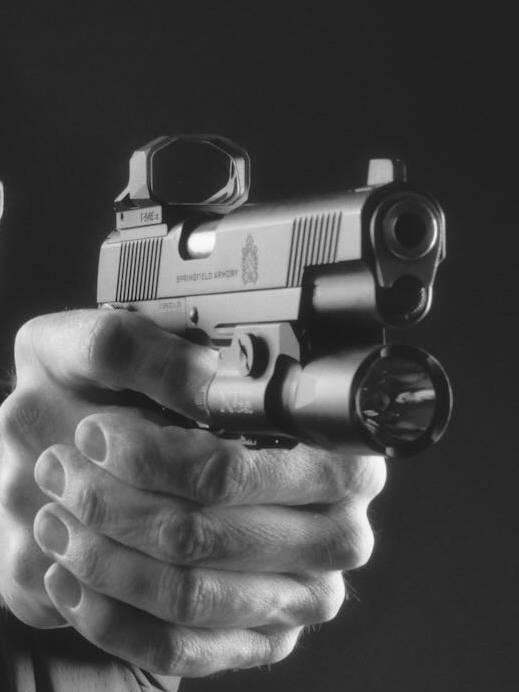




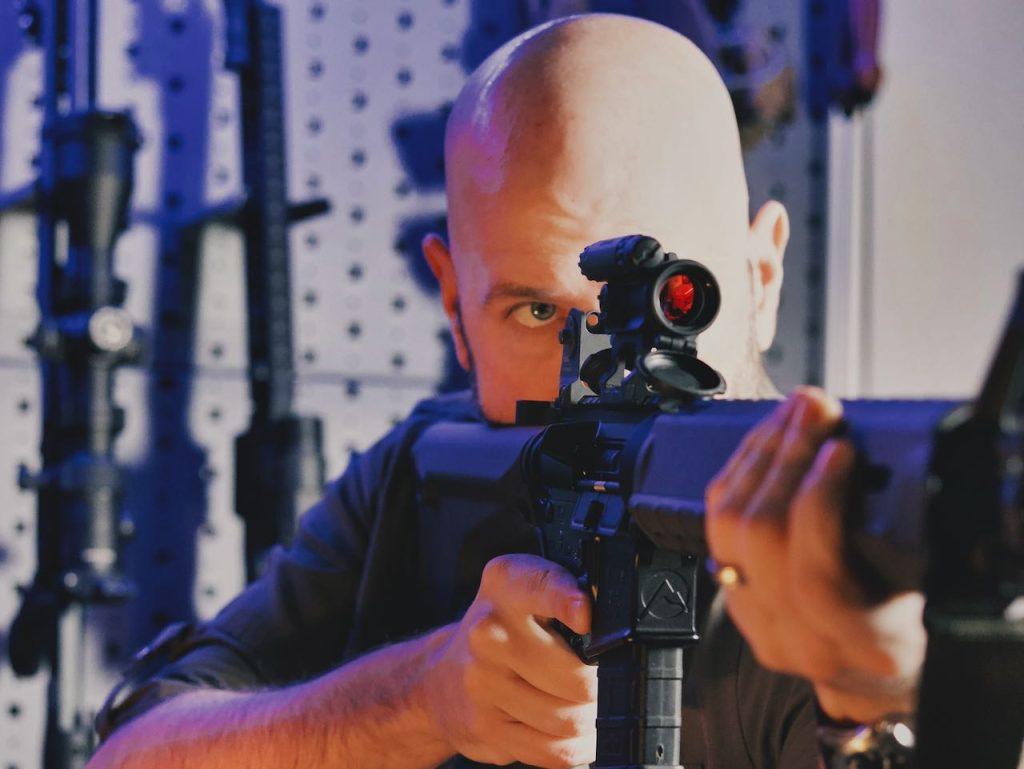
Using Optics to Learn the Fundamentals
The simple truth is that optics makes learning marksmanship easier. Optics remove a few variables from the equation, which simplifies the whole process.
Simplifying Alignment
First, they remove reduce the number of things that need aligning. With iron sights, must align the front and rear sight correctly, and then align your eye behind the rear sight- then keep all of that aligned to the target. That’s four separate items that must stay in line for a good shot.
With optics, you reduce that by one point. You need to align your eye to the optic, and the optic to the target. That’s dramatically easier to manage, especially when using high quality red dots that reduce the parallax issue to essentially nothing. In those cases, the eye position is nearly irrelevant and you only need to align the optic to the target.
Simplifying Focus
The other dramatic improvement with optics is where you focus your eye. With optics, the focus is always on the target.
That feels like a natural thing to say, and beginners intuitively understand the concept, which makes learning how to shoot with optics that much easier- especially under stress.
With irons, you’re supposed to focus on the front sight. Of course, you do that after you’ve correctly aligned it to the target, which means you have to shift your focus between the target and the front sight before finalizing the sight picture with a focus on the front sight in relation to the rear sight. Unlike video games, focusing on the front sight makes your target blurry. The shorter the sight radius, such as with pistols, the worse this effect becomes.
Gaining proficiency with iron sights takes far more time to master, because it’s not intuitive.
Iron Sights vs Optics
Don’t take any of this as me saying that iron sights are terrible and you shouldn’t bother learning them. In fact, I think they have a lot of uses.
Compared to optics, iron sights have a lot of benefits
- Cheaper
- No batteries required
- Lighter
- No fogging in inclement weather
- Less likely to get bumped off their settings
- Do not care about water intrusion
- Easier to clean
- Offer a decent point shooting reference
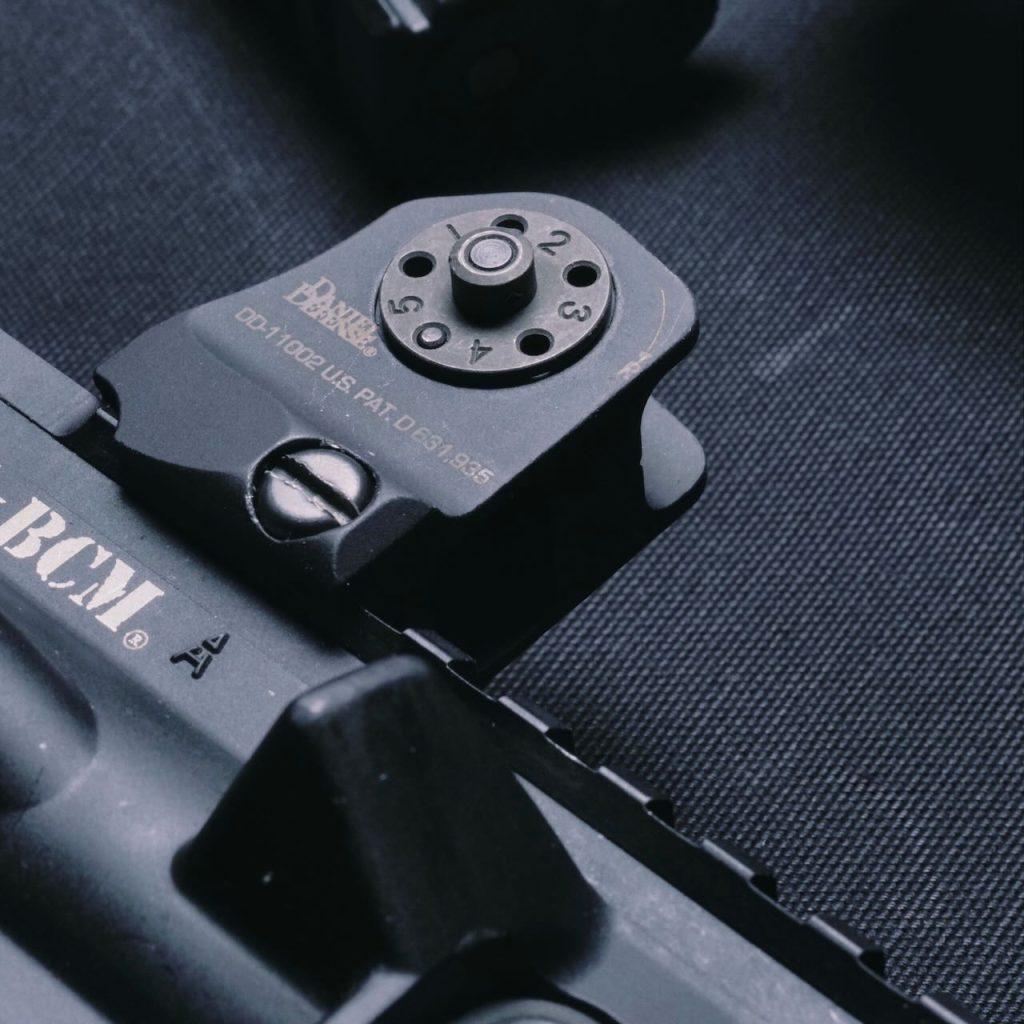
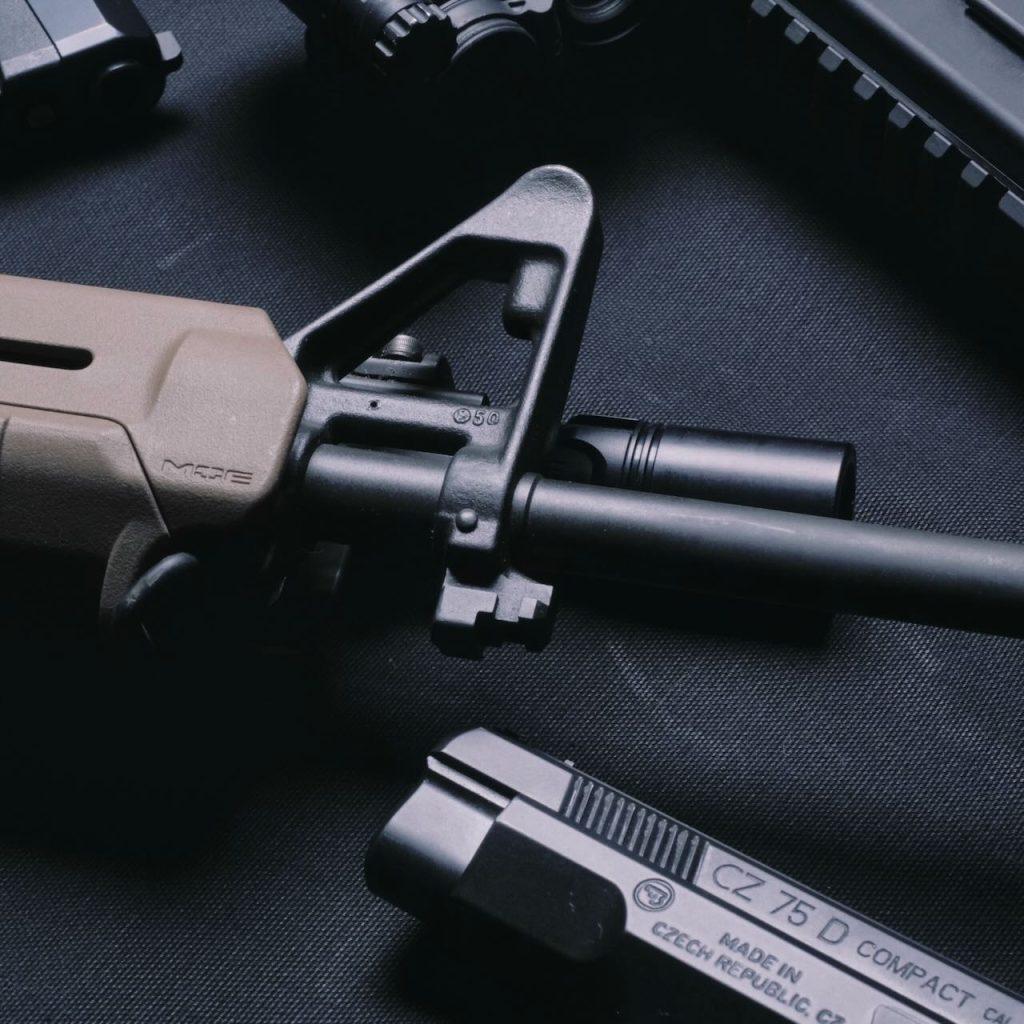
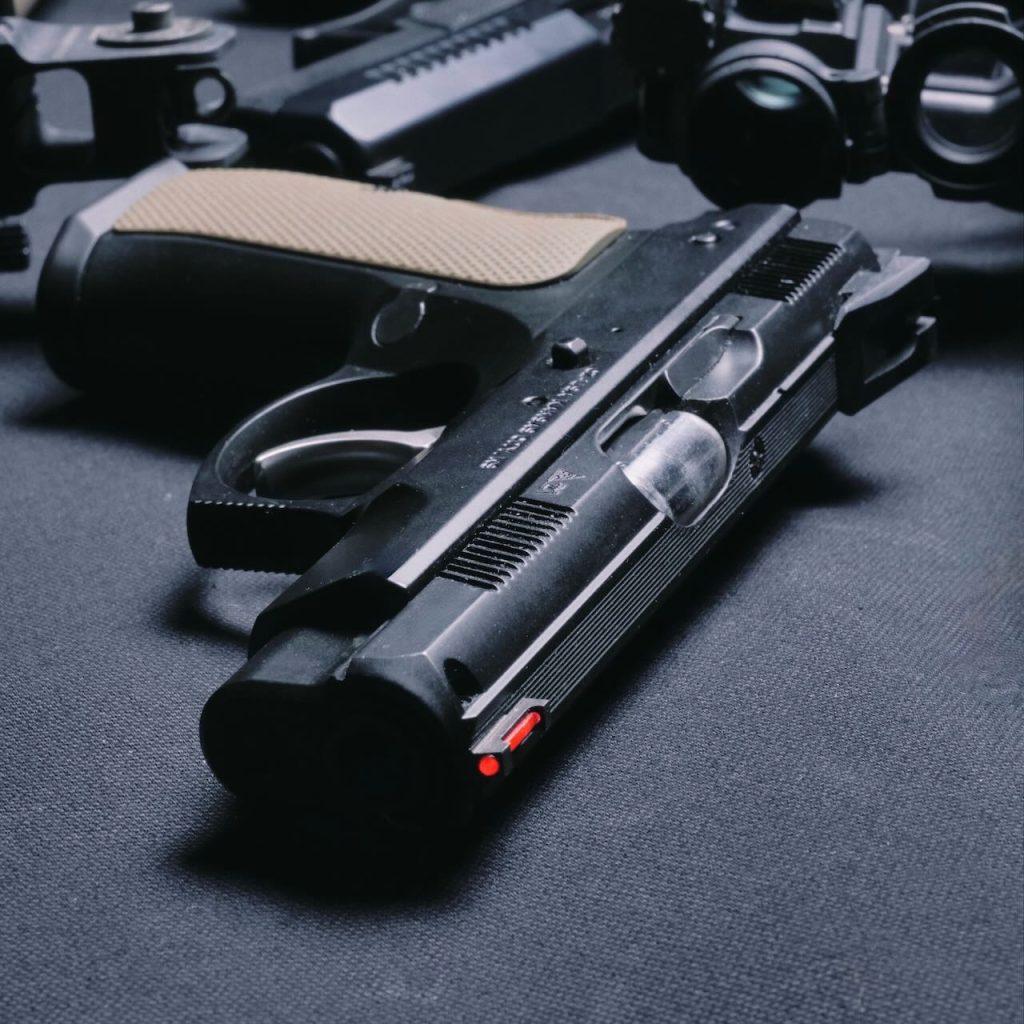
When you look at that list, irons seem like a pretty good option for austere environments. I’ve read several reports from military units to training in jungle environments. A lot of the lessons learned include the difficulties with magnified or battery powered optics, and a preference for going back to iron sights.
Irons work very well for that.
But, they still have all the same downsides. Compared to iron sights, optics are
- Faster to acquire
- Red dot sights are more forgiving of parallax error
- Offer better range and wind estimation
- Magnified optics provide dramatically improved capability to locate targets, which is a huge
- Provide better target positive identification since you focus on the target and not the sight itself
Which Do You Choose
If you’ve read my article on selecting your first AR-15, then you might recall my suggestion on sighting devices:
If you have the funds to buy a quality optic right now, either red dot sight or magnified scope, then go that route. However, if you don’t have the funds available, then I say stick to a decent set of iron sights until you can save up for the optic.
A quality set of irons aren’t expensive, and they will serve you well for a long time.
I hate the idea of people buying something cheap now and then something nicer later. Inevitably, they end up buying two or three of the cheap optics as they break. Had they stuck with the irons for a while, they would still gain the skill and experience and not wasted their money.
When it comes to handguns, the same rule applies. Many shooters are learning pistol shooting from the get go with optics. I don’t see a problem with that as long as they commit to routine maintenance and verification that the pistol optic remains secure and powered.
Iron sights are not magic voodoo. They are useful, but more difficult to master. The people who preach that everyone should learn irons first as “fundamentals” are stuck in the last century. I say focus on the actual fundamentals first, regardless of your sighting system.
What About Backup Irons?
Of course, either/or isn’t a real problem. Most people usually have a combination of irons and optics on the same gun…where it makes sense.
So what does that mean?
Here’s my general rule: If you can keep iron sights on your weapon, then you should. But only do this if they do not interfere with your primary optic system. For example, iron sights mixed with red dots are an obvious green light since there there are no concerns around eye relief. With magnified optics, that’s a different calculation. For example, I have magnified prism optics that I need to mount as far back on the rifle as possible in order to optimize eye relief and head position. Moving them forward enough to have room for a rear iron sight means compromising my head position and actual marksmanship fundamentals.
That’s not worth it.
With pistols, my preference is always to have iron sights that cowitness with an optic, if possible.
Iron Sights Are a Skill
To close this one out, let me reiterate something: iron sights are a skill. I spent this article telling you why they aren’t fundamental to marksmanship, and why optics are superior, but that doesn’t mean I don’t think people should learn to use them well.
You never know when you might find yourself in a situation where the only thing available to you is a weapon equipped with irons. It’s a bit like needing to drive your friend home from the bar in his car- and it’s a stick shift. It’s a good skill to know and be reasonably competent with, even if it’s not the thing you do all of the time.






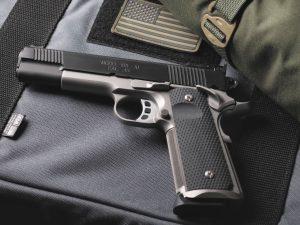

Always enjoy an article. I have been thinking a lot about this conundrum lately. I have previously scored 227 Appleseed but using a magnified optic last April. I have been doing my best to master Iron Sights since then and I have become better than I ever thought I would be with them (almost 40 years of age now) but some rounds are better than others. Just differentiating the front sight from the target becomes difficult and shooting into a blur is just odd. Should I just accept the optics and that I am as good as I will ever be with Iron Sights?
Hey John! I always think iron sights are worth mastering. I used them for my Appleseed event as well, and I missed the Rifleman badge by one point. I know I would have made it, and then some, had I used optics.
Eyesight definitely plays a role, but I think it’s more about practice than anything. There’s nothing wrong with relying on optics. They absolutely have benefits and should be the primary way of sighting your rifle. I just get frustrated when I see others talking like learning to shoot with irons is a foundational skill these days. It’s useful, for sure, but not foundational.
“Focus on fundamentals first” is on point!!!
Hey Jeff! Thanks for commenting. I’m glad you approve of that idea, it’s huge! So many people try to circumvent fundamentals by spending more money on gadgets.
Good points. Iron sights are not fundamental, they’re just a device to visually confirm alignment. The shot process demands learning to consistently align the barrel sufficiently well enough to land a hit and does not care how you obtained and confirmed that alignment.
Working with Army personnel taking the Squad Designated Marksman course as prescribed in the old FM 3-22.9 from 2008, it was common for shooters to post a higher score on their first Table using irons than the second Table using an ACOG. Not because of “magic” by using iron sights but because these shooters happened to be more familiar with them compared to the new-to-them optic.
Practice is number one. Like I mentioned with Jeff, too many people think expensive gadgets are the solution to shooting better. But they will never be able to outshoot someone like you who has out in the time and practice, even if they’ve got the fanciest gear and you’ve got something bare bones.
That’s an interesting note about the ACOG performance. Like you said, it came down to familiarity and practice. I’m sure they adapted quickly and then further increased their performance because they already had solid foundations.
Hello John!
Allow me a couple of quibbles. You put the process of aligning the front and rear sights with each other under the heading of “sight picture” and not “sight alignment”. In approximately 46 years of reading about shooting, you are only the second person I’ve seen put things that way (the other was Ken Hackathorn, one of Jeff Cooper’s comrades in the early days of modern practical pistol shooting). Everyone else calls aligning the sights with each other “sight alignment” and then calls moving the set of aligned sights onto the target in proper aiming position “sight picture”. Just an observation. The other quibble is that irons really aren’t “so last century”. Heck we had red dots back in the ancient days of the 1980’s along with simple but quality rifle scopes, big hair, the Cold War, Ronald Reagan, and horses and buggies. I think it is highly advisable for every rifle shooter to learn irons well, including the nearly useless semi-buckhorn-and-bead types that come with most bolt and lever action hunting rifles. The reason is that one never knows what one will wind up having to shoot, whether at a casual trip to a range or having a totally unexpected situation beyond your control forced on you. I notice that Marlin has put squared Partridge-type (like a handgun) sights on some of their .22 rimfire rifles. Much better than the foregoing, but still not up to good GI-type aperture and post. The latter I love using but have been… Read more »
Hey Pete!
You ain’t wrong. I didn’t know I was going against the grain like that, much less that Ken Hackathorn was my only company, lol.
Looking back over my notes, though, I think it was an honest mixup. Consider it corrected 🙂
I do love me some iron sights, though. I agree with you, every shooter should learn to use irons well. My main quibble is with those that insist someone MUST learn irons first as part of their fundamentals. Of course, I’m always up for a spirited and friendly debate!
Also, I’m glad to have John commenting! Both he and you, among others, are a big source of my inspiration and drive.
On a side note, I remember a comment thread a few years back on the old site. I was talking about pack weights for the field and you mentioned some of the gear you bring along. I remember you actually caused me to go out and buy one of those nice heavy space blankets, among others things. I think that subject is due for a revisit!
I like having one of those space tarps handy. Fortunately I’ve never had to put one to the test on a cold night out in the woods!
On another side note, thanks for that article on knots. Still trying to puzzle my way through it, but that subject is a major weak point for me.
You’re very welcome. I want to do some more of the outdoors skills posts, but I just have so many more marksmanship oriented stuff already planned.
High on my list right now is knife selection and tarp shelter configurations.
I agree with some of your points. However as a retired Marine I feel you should become proficient with irons first. I can hit what I am shooting at with decent accuracy at 500 yards yes with time your eye sight fades and optics are very important just my two cents
I believe that mastering iron sights should be the first priority for shooters. Understanding how to properly set and use iron sights is fundamental, as it aids in making accurate adjustments across various equipment, from pistols to bows. Iron sights also provide critical testing of environmental conditions such as wind and distance. One of the challenges with relying on technology is that it becomes ineffective when power is lost. In situations where electronic sights malfunction or lose power, having well-trained iron sight skills is invaluable. Additionally, I own a set of sights that do not require batteries or power sources. It’s important to recognize that battery-powered sights can fail unexpectedly, often at inconvenient times, highlighting the importance of proficiency with traditional iron sights.
Matt I wanted to come back and clarify something. I don’t own any optics as a matter of fact every time I have tried to use one I am just terrible with them probably a lack of understanding and practice I am not a competitive shooter nor was I a great shooter in the Marines just learned to be proficient with the irons I have no beef with optics they just confuse me so I have just stuck with what works for me
Semper Fi
Keith, thanks for coming by and commenting! Irons are absolutely a great tool to master. You’re not the first Marine to tell me that you need to become proficient with irons before learning optics, either. Given your experience, I’m not surprised at your ability with irons, either. But that’s also your experience, and you were taught irons from the very beginning.
If you put yourself in the boots of a brand new recruit today, who learns on an ACOG from the beginning, then the experience is totally different. I still think everyone really should learn and get proficient with irons, I just don’t think they count as the “fundamentals” of shooting.
I feel that iron sights require more patience along with fundamentals more than red dots or else you wont get a hit. Its soo much easier with red dots that you can sacrifice fundamentals.
Hey Ivan, I definitely agree that optics make the whole sighting process much easier. I still wouldn’t say that the fundamentals apply “less,” though. But I do see your point that optics speed things up sufficiently enough that you might not need to hold for as steady or as long to get the shot off.
I was trained by my uncles who were old school military guys in marksmanship. The iron sights first ideology was strong in their teachings and that is how I have thought as well. But to think about it after reading your article, that does leave the argument that usually when teaching (anything) you start with the easy and work towards the hard. Which kind of leans toward starting with optics.
I guess in my opinion the most important fact is you should learn and try to master both.
Hey Michael, thanks for reading and commenting! I really do think the “irons first” mentality is heavily influenced by those who served in the military before optics were widely available. But, as I found while researching and writing this post, irons aren’t really part of the marksmanship fundamentals. So, by my thinking, if I can give the student one less thing to worry about then they are going to have a better time and learn quicker.
I still see iron sights like a manual transmission on a car. Can you learn how to drive on an automatic? Absolutely. It’s much more difficult to learn how to drive a manual transmission after learning on an automatic. Learning on a manual first isn’t easy. Learning how to drive an automatic afterwards is much easier.
I think that it is generally the same with sights. Plus, how many rifles (especially surplus rifles) do not have optics? Or even the ready capability to take optics? If a new shooter only knows how to shoot with optics and wants to shoot my sweet SMLE, they probably won;t be able to hit anything. And that would just be sad.
Hey Pete! I think that’s a good analogy. is learning to drive a manual absolutely necessary these days? Probably not. But knowing how to do it does help you be a more well-rounded driver who can handle unexpected situations.
You can learn the fundamentals of marksmanship with an optic, but learning irons along the way better prepares you to handle rifles not equipped with them, or if situations arise where optics aren’t going to cut it.
The scope on my AR broke and I took it off last week. I installed Magpul sights on it. The next morning I zeroed it before participating in a 2-gun match. The match was heavily weighted for pistols and I sucked. I’m not being overly humble, I need to work on my pistol shooting a lot. Anyways, the last stage had 3 “long range” rifle targets. I put that in quotes because the farthest one was about 150 yards away. However it was six-inch diameter popper. Every other competitor had a scope on their rifle and most of them took several shots at it before hitting. When it was my turn a few people made comments about me using irons. I hit that target with a single shot. The reaction from the crowd was great!
I of course made a shameless plug for Project Appleseed.
I have started to forego scopes more and more just because they never seem to be able to hold zero. Almost every rifle, every scope I have ever owned always shoots well; I am an experienced shooter than can make the most of any ammo/gun combination such that if the platform as being shot is capable of say 1MOA or better, I can shoot that. Unfortunately, it seems like I have to sight in the scope almost every range session as if the temperature had a big change on point of impact. Steady temps don’t see changes in zero but if have to wear more (or less) clothes and the temps drift by a lot then the point of impact also changes more than you would expect by changing muzzle velocity. What is more is that the groups are consistent, so if that day the gun seems to pring high and to the right, the groups are the same size as always, just in that high and to the right direction. I don’t think it’s bad installation, faulty scopes or anything I am doing due to this consistency in how the scope will shift its zero. So for any gun used for defensive or important purposes, like hunting I would never use a scope and rely on iron open sights which never seem to have this problem. I think scopes and their rings might have a different reaction to temp changes than say the gun, stock or barrel and introduce… Read more »
Oddly enough, you’re not the first person to leave a comment about that around here. I’ve never had an issue with an optic keeping its zero so long as I’m running the same ammunition from trip to trip. I wonder if there’s something else going on.
Scopes are cheating at anything less than 400 yards unless the target is smaller than an inch wide. That’s how I was taught. I also shot pistol at dangling pieces of thread from 50 feet.
Iron sights taught me far more precision that optics every could.
I feel it’s more of a learn to drive a stick shift vs learn to drive a self driving car situation.
Put the time and effort into shooting with irons, optics come easy after that with just a little practice.
The very best shots I’ve been around have all started shooting with irons, they called that learning the basics and laying down good shooting habits. The guys I know that started with optics are a little bit of a joke, I can shoot circles around them all day every day in any position and I’m only an ok shot.
Just my personal experiences.
Thanks very much for great information.
I thought the main reason that iron sights were considered “fundamental” is their pure reliability. Optics are more susceptible to breakage, battery or electronics failure, etc. Is that not the case?
In this case, I’m referring to the fundamentals of marksmanship. There’s a lot of people who say that you must learn irons before you move to optics, that they are “fundamental” to shooting. To that, I disagree. It’s an important skill, for sure, and irons are certainly going to be a solid backup if a primary optic fails, but I don’t think they are strictly required.
HAve you ever heard of Palma? Those guys shoot itty bitty groups at 1000 using…..that’s rite a peep sight.
I’ve got a simple reason for starting with iron sights: that’s what comes on a BB/pellet gun.
I started my shooting career with a Red Ryder BB gun at the ripe old age of 8, and it was a fantastic introduction to shooting. You can buy a jar of 6000 BBs for less than 10 bucks and throw rounds around to your hearts content, and nothing teaches the fundamentals of marksmanship like practice. I shot everything from tin cans to carpenter bees with that crummy little gun, and loved every minute of it. I remember whittling a wedge for the rear sight so I could get more precise adjustments than that horrible plastic wedge that came with the gun.
I like scopes a lot, and would never disparage someone for learning to shoot with one, but I’ll always remember that old Red Ryder whenever I shoot with iron sights, and there’s a little bit of magic in that.
I think the idea is similar to learning to play guitar on a steel string acoustic, so when you pick up an electric with its easy, light action, you find it easy.
There is a certain type of value in starting with the more difficult thing before showing the easier way. But on the other hand, I also think there’s more value in making the experience fun and immediately rewarding.
To use your guitar example, is it a better approach to take someone interested in learning guitar and forcing them to practice scales over and over on day 1, or would be a quicker win to show them power chords and have them play a few well known riffs?
Either way, they are now playing the guitar- but the second avenue gave them a quick and rewarding win that’s more likely to bring them back.
With good instruction, learning iron sights is no hurdle at all. I took a Rifle Immersion: Midrange Rifle class at Valor Ridge, and I was able to keep up with the guys running LPVOs and red dots. Irons force you to be consistent with fundamentals to achieve hits. This can be a great training tool to kill bad habits before they become big problems.
If a new shooter came to me asking for a roadmap to great marksmanship, I would tell them to use the money they would have spent on a quality, non-CCP optic system on a Valor Ridge class and ammo instead. They’ll find out how to use irons and their limitations in a practical marksmanship sense. They’ll also find out how rifle weight affects them over the course of several days. Afterwards they can make the decision on purchasing an optic if they feel outgunned.
For me personally, I’m going to master VR’s rifle standards before going to an optic. Even if I do add an optic, I will practice with irons at every range and dry fire session. Furthermore, I’m going to purchase an IR illuminator/pointer and PVS14 before adding an optic. I don’t feel outgunned with irons and a white light for home defense, but I definitely feel outgunned without night vision capability vs bad guys with NODS.
Good article with good points. Keep up the good work.
Let me kindly, but firmly disagree with you :). It starts with the way you are referring to the “Fundamentals of Marksmanship” as sort of a quasi-religious testament that supposedly has all the answers to all the questions within itself. It does not. So, you are basing the whole argument on the wrong premise, a simple logical fallacy. But let’s try to go your way and see what else you got wrong. So, you say that Iron Sights are not fundamental just because they are not mentioned in the list of the fundamentals? You know what else is not mentioned there? The barrel, the ammo, a well-fit functioning weapon! 🙂 You got to have a barrel to be able to shoot, do you agree? Following your logic, a good working gun is not one of the fundamentals of marksmanship, because it is not in your list, right? Right… Iron sights are the most fundamental, because they teach the alignment of a gun relative to the target. One may have static sights, like on some cheap .22 rifles and still be able to aim reasonably well just by aiming “above, to the left, to the right” – and it takes a real marksmanship to do that!. A good marksman should be able to aim fairly without any sight at all – just by using the sense of the distance, elevation, wind and knowledge of ballistics. Scopes, red dots are excellent tools, as long as they are well-sighted, but they fail to… Read more »
Agreed
Just back from the range. Helped a noob get AK iron sights set up. Took 10 minutes. We spent an hour getting the red dot close. Another hour, and couldn’t get the other red dot close at 25m. I was letting him figure out the adjustments and only spotting. It seems there are fundamentals like, point of aim, point of impact, elevation, and windage that are skipped in school.
Good analogy: competence with iron sights and being able to drive a stick.
I wholeheartedly disagree. My personal observations on the range, in casual, competitive, and combat training, and all else being equal (same rifles, same sights, same targets, same courses of fire), the people who have more experience with iron sights tend to shoot more accurately, and more quickly, with any sighting system given to them. Didn’t matter if it was RDS, LPVO, ACOG, Irons, or no sight at all. Something about learning iron sights embeds all those other fundamentals of marksmanship into your muscle memory from the start. Sight alignment and picture are (arguably) just one portion of the equation that also includes the positioning, breathing, and trigger press. Iron sights force all of those other fundamentals in ways that RDS or LPVO don’t seem to – Not to the same extent, anyways. The habits built when learning to shoot irons are, by nature of the difficulty of irons, good habits to have, and they apply to all other sighting systems. The bad habits that other sighting systems allow new shooters to become accustomed to will only cause issues further on in that shooter’s career, when they inevitably have to break those bad habits to learn a different sighting system. This isn’t to say that a “Modern” shooter who has only ever known a RDS can’t be fast or accurate, and can’t build good habits from the start, but there’s just an increasing likelihood that they will not. Starting a new shooter on iron sights enforces may not be expressly dictated… Read more »
I like to use the co-witness system, just in case.
Iron sights all day